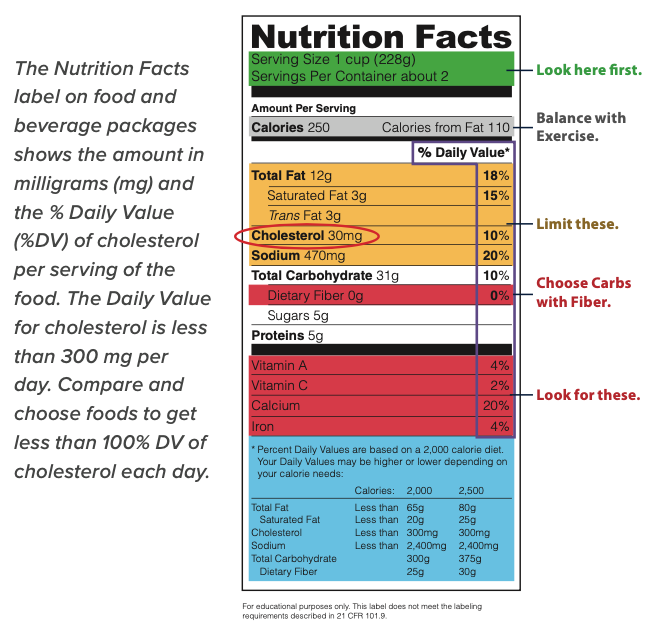What is cholesterol and when is it dangerous?
Cholesterol is a waxy substance (lipid) that our body creates to aid in cell production.1 Cholesterol is made by the liver and circulates throughout the body via the bloodstream. Many of the foods that we eat also contain cholesterol, including foods from animal sources, such as meat, poultry, and full-fat dairy products. When foods that are high in saturated/trans fats are consumed, the liver makes additional cholesterol, which causes plaque buildup, making it difficult for the heart to circulate blood throughout the body. Plaque increases the risk of strokes and heart attacks by bursting open and producing a clot that blocks an artery, or arteries, interfering with the circulation of blood to the brain or heart, depending on which artery is blocked.

Why does our body make something that is bad for us?2
The body possesses both good and bad cholesterol. Bad cholesterol is known as low-density lipoprotein (LDL) and good cholesterol is known as high-density lipoprotein (HDL). Your liver “normally” makes all the cholesterol that your body needs. Cholesterol becomes a problem when high trans/saturated food consumption adds excess cholesterol to the body. LDL cholesterol is the type of cholesterol that causes plaque formation and leads to atherosclerosis, and related conditions such as heart attacks, strokes and peripheral artery disease. Atherosclerosis occurs when the arteries harden and lose their elasticity from plaque buildup.
As previously mentioned, HDL cholesterol is good cholesterol.2 HDL counteracts LDL cholesterol by removing it from the arteries and taking it back to the liver. Adequate HDL cholesterol levels reduce the risk of heart and brain attacks by carrying up to one-third of LDL (bad) cholesterol back to the liver. Low levels of HDL cholesterol also pose further risk of heart disease.
Like cholesterol, triglycerides is a lipid that is found in the body. The amount of triglycerides in the body are an important indicator of metabolic health. Excess, or unhealthy (trans/ saturated fats), triglycerides (like excess LDL cholesterol) increase the risk of chronic diseases, such as atherosclerosis, diabetes, and heart disease. The following factors increase your risk of high LDL cholesterol/triglycerides: Overweight/obesity, sedentary lifestyle (physically inactive), smoking cigarettes, excessive alcohol consumption, diet consisting of > 60% carbohydrates, and genetic predisposition or underlying diseases.

What are the symptoms of high cholesterol/ triglycerides?3
There are typically no symptoms of high cholesterol, which is why it is important to have your healthcare provider monitor your cholesterol levels. Routine monitoring of your cholesterol and triglyceride levels allows your healthcare provider to assess your risk of a heart attack, stroke, and related complications, and provide treatment on a regular basis. A baseline cholesterol should be obtained beginning at 20 years of age, or sooner if there is an extensive history of high cholesterol/triglycerides among younger family members. It is important to visit your healthcare provider if you or a member of your family has a history of high cholesterol but hasn’t had it checked recently.
Reading nutrition labels is one way to tell how much/what kinds of fats you are eating, which foods to avoid, and which foods are most nutritious. Living a healthy lifestyle, knowing your fats, reading and understanding food labels, and checking your cholesterol/triglyceride levels routinely are positive risk reducers that lead to optimal, high-quality health.
Remember: Saturated and Trans Fats INCREASE LDL (bad cholesterol) levels. Unsaturated Fats DECREASE LDL (bad cholesterol) levels.

©2022HealthSpot References: (1) American Heart Association. (2016). About cholesterol. Retrieved from http://www.heart.org/HEARTORG/Conditions/Cholesterol/Cholesterol_ UCM_001089_SubHomePage.jsp (2) American Heart Association. (2017). Good cholesterol vs. bad cholesterol. Retrieved from http://www.heart.org/HEARTORG/Conditions/ Cholesterol/AboutCholesterol/Good-vs-Bad-Cholesterol_UCM_305561_Article.jsp#.WH- u0VMrLIU (3) American Heart Association. (2016). Symptoms, diagnosis, & monitoring of high cholesterol. Retrieved from http://www.heart.org/HEARTORG/Conditions/Cholesterol/ SymptomsDiagnosisMonitoringofHighCholesterol/Symptoms-Diagnosis-Monitoring-of-High- Cholesterol_UCM_001214_Article.jsp#.WH-zYlMrLIU

